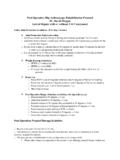Transcription of MET: Posterior (backward) Rotation of the Innominate Bone.
1 MET: Posterior (backward) Rotation of the Innominate Bone. Purpose: To reduce an anterior Rotation of the Innominate bone at the SI joint. To increase Posterior (backward) Rotation of the SI joint. precautions : Make sure during the procedure that the lumbar spine does not come off of the table. Procedure: The patient is supine with the hip flexed to tissue resistance. Place the ankle on your shoulder. Stabilize the opposite Innominate bone with your other hand. (Not shown in photo). Have the patient try to extend the hip followed by flexing the knee for 7 seconds as you resist this motion with your shoulder. Ask patient to take a breath in and relax. Move your hand from the opposite ilium to the ischium while your outside hand is placed on the iliac crest. Induce a Posterior mobilization while simultaneously leaning forward increasing hip flexion. Repeat this procedure 2-5 times depending on the amount of the correction required.
2 Reassess. Helpful suggestions: 9 Set the table height so that you can keep your back straight maintaining your lordosis. Also, if the patient has strong legs, ask him/her to build up the contraction of the hip extensors slowly as you may not be able to resist the heavy contraction. 167 MET: Anterior (forward) Rotation of the Innominate Bone. Purpose: To reduce Posterior Rotation of the Innominate bone at the SI joint. To increase anterior (forward) Rotation of the SI joint. precautions : This position stretches the femoral nerve. If the patient experiences any neurological symptoms during the procedure, discontinue Procedure: Position the patient prone with the hip extended and the knee flexed to point of tension. Palpate the PSIS as you are extending the hip. When the PSIS has finished moving superiorly this is the point of tension or the feather edge barrier you need to achieve in order to be affective with the mobilization.
3 Ask the patient to push into your knee (by flexing the hip) followed by straightening the knee (contraction of rectus femoris). Contraction phase 7 seconds, ask patient to take a breath in and relax. (about 3 seconds) Induce an anterior glide of the ilium by first extending the hip to the new point of tension followed by an anterior-superior mobilization of the PSIS and the iliac crest with your palm and thenar eminence of your hand as shown. Allow 10 seconds for this to occur. Repeat this procedure 2-5 times depending on the correction required. Reassess. Helpful suggestions: 9 You may wish to place your knee under their knee to provide support and to reduce the strain of lifting a heavy leg. 168 MET: Lateral Glide of the PSIS and to Gap the SI joint. Purpose: To correct for an pelvic outflare, to increase lateral glide of the Ilium on the sacrum, to Gap the SI joint, to unlock the SI joint.
4 precautions : If a muscle spasm occurs, discontinue. Sometimes this occurs in the tensor fascia lata or hip abductor muscles. Procedure: Position leg into flexion and adduction while palpating the PSIS for lateral movement. Take the up the slack in the SI joint. Ask the patient to first flex and adduct the hip (knee towards opposite shoulder) followed by lateral Rotation of the femur (pulling the ankle medially against your arm). Resist these two actions simultaneously. This is the contraction phase (7 seconds). Ask patient to take a breath in and relax. (about 3 seconds) Induce a lateral movement of the PSIS by repositioning the thigh into further adduction and flexion as you traction the PSIS with your fingers (10 seconds) Repeat this procedure 2-5 times depending of the correction required. Reassess. Helpful suggestions: 9 To get started have the patient help you by extending their knee so that the leg is positioned into your axilla then use your elbow to pull the leg into your side.
5 MET: Lateral Glide of the ASIS and to Gap the Anterior SI joint. Purpose: To reduce an Inflare of the Ilium. precautions : Don t press too hard on the ASIS as this can be a sensitive area. Also if the TFL or Gluteal medius wants to go into spasm. Discontinue and go to a direct technique. Procedure: Position the leg into flexion, abduction and external Rotation as shown (to the point of tension). Stabilize the opposite pelvis with your palm over the ASIS and iliac crest. Place your hand on the lateral surface of the knee and have the patient push into abduction and lateral Rotation . Do not let the leg/thigh move(Isometric contraction). Contract for 7 seconds; take up the slack by moving the leg/thigh into further abduction and lateral Rotation (second picture). Repeat 3-5 times and reassess. Helpful suggestions: 9 Have the table set higher so that you don t have to flex your back while stabilizing the pelvis.
6 You may need to place a towel or sheet over the ASIS you are stabilizing to reduce point pressure. 170 Active phase Passive phase Personal Notes _____ 171






